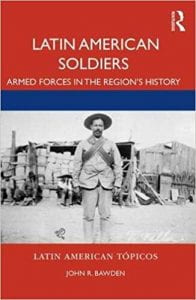A Review of Latin American Soldiers
The Role of the Military in Latin America

Latin American Soldiers: Armed Forces in the Region’s History by John R. Bawden (New York: Routledge, 2020)
John R. Bawden’s Latin American Soldiers: Armed Forces in the Region’s History introduces readers to the study of Latin American’s Armed Forces., Bawden examines warfare and military traditions in four different countries (Mexico, Cuba, Brazil and Chile). In each one of those nations, the military, despite their diversity in size, composition and training, is considered by many to be the cement that holds their societies together. It is not the first time he has written about the miitary: Bawden, who teaches history at the University of Montevallo, is also the author of The Pinochet Generation: The Chilean Military in the Twentieth Century (2016).
The military, an institution with the monopoly over the use of force within many Latin American countries, is a highly respected organization whose primary functions are to defend and protect the Constitution. For example, in the Brazilian Constitution, promulgated in 1988 Article 142, states clearly that the Armed Forces is under the tutelage of the President of the Republic, with its primary function to protect of the country. In many countries in Latin America, the Armed Forces have taken upon themselves to exercise its poder moderador or moderating power. The Armed Forces’ poder moderador is its ability, granted to the military by none other than the military themselves, to intervene in the political affairs of the nation when other political institutions cannot guarantee the security and welfare of its citizens.
Bawden also discussed the role of the military as an important agency of state-building, “reflecting and shaping Latin America reality for centuries” (p. 173). According to Bawden, the military in Latin America have helped deal with many of the problems faced by postcolonial states in the aftermath of independence such as defining borders, dealing with imperialism and internal conflicts and coping with dependent economies..
Modernization of the military in Latin America took place between the late 19th and mid-20th centuries. More than just the purchase of the latest machines of war, modernization was also about creating a professional military institution, according to Bawden The professionalization and modernization of the Armed Forces in the Americas begins with the creation of Army staff colleges. Those colleges would familiarize future leaders to the relationship between a professional military force and the future of the nation. In the Army staff colleges, future leaders would be indoctrinated into the binomial security and progress. A nation could not prosper under stress. Thus, the military was the Leviathan that provided peace while advancing progress. The military also functioned as a social service organization. As Bawden states, “officers taught conscripts to read and write and marched soldiers past crowds during civic events” (p. 17). The professional soldier was a symbol of pride. Again, Bawden contends that “professional soldiers may entertain the idea that they are virtuous warrior-priests who defend the nation’s permanent interests while civilian leaders are venal and incompetent” (p. 17).
Another important element in the professionalization of the Armed Forces in Latin America was the adoption of the National Security Doctrine (NSD) (p. 21). Latin America’s national security doctrine was heavily influenced by its fight against Communism and subversion, leading the military to rationalized its involvement in the political system to maintain internal order and to combat ideologies, organizations and movements sympathetic to Marxism, Socialism or Communism.
The U.S. Army School of the Americas was an instrumental agency in the proliferation of the national security doctrine in Latin America since many of its future military leaders were educated at Fort Benning, Georgia. The adoption of a national security doctrine led many nations in Latin America to commit some of the worst human rights abuses in the name of order and progress. Countless number of individuals would disappear during Latin America’s dirty war. The NSD called for militaries to assume power and to overthrow the legitimate elected governments of Salvador Allende in Chile and João Goulart in Brazil under the guise of revolutionaries coming to power (p. 78). Obviously, the ascendancy of Fidel Castro to power in Cuba sent a shockwave throughout the Americas and the domino effect became a reality that a military intervention could remedy the malfeasance of society. Revolutionary intervention was a cancer that required all means necessary to combat it, many argued.
With the collapse of the Soviet Union and the “end of history,” Latin American Armed Forces attempted to find its new niche in the new international system dominated by the lone superpower, the United States, and the “Rise of the Rest,” such as Russia, China, Iran and North Korea. Today, Latin American Armed Forces are actively not only still protecting the national integrity of the state, but also fighting the war of terror, the war on drugs, and adapting to new realities. Participation in the Blue Helmet missions and peacekeeping operations have provided Latin American militaries with exposure to the new problems of the 21st century. For example, Argentina has been one of the world’s most consistent peacekeepers since it emerged from dictatorship in 1983 and Brazil led the military component of the UN Stabilization Mission in Haiti from 2004 to 2017 (p. 25). While some countries actively pursue an opportunity to participate in the international system, others are not so enthusiastic. For example, while Mexico is the third largest country in Latin America after Brazil and Colombia, it does not have the pretension to project power outside of the hemisphere (p. 58). Mexico’s Armed Forces are more concerned about its own domestic problems, including but not limited to, its war on drugs against the powerful cartels.
Military regimes in Latin America have a different mission than military regimes in other parts of the world, especially the developed North. While the primary concern of the Developed North is external enemies, Latin American nations must first address its internal problems such as political instability and its own political survival. Why study Latin American militaries? What weight do they have in the largest political landscape in the aftermath of the implosion of the Soviet Union? Those questions are not rhetorical. They are important for the advancement of knowledge in a Kuhnian tradition. As Bawden contends, “studying militaries in Latin America therefore helps us to understand the world and especially contemporary issues in the developing world such as rapid population growth; demands for social reform; and difficult, internal security challenges” (p. 173). In the final analysis, the military in Latin America still represents a symbol of power.
In conclusion, I recommend Bawden’s Latin American Soldiers: Armed Forces in the Region’s History to anyone interested in Latin American history, military history or civil-military relations in the Americas. While the book only covers four countries in Latin America, those four countries can be considered representative of the military in Latin America— especially in the case of Brazil, which is the largest country in terms of population, a continental country and considered a regional power.
Spring/Summer 2020, Volume XIX, Number 3
José de Arimatéia da Cruz is Professor of International Relations and Comparative Politics at Georgia Southern University and US Army War College Strategic Studies Institute.
Related Articles
A Review of Default: The Landmark Court Battle over Argentina’s $100 Billion Debt Restructuring
In February 2019, I found myself serving as the special attorney general for the then newly recognized interim government of Venezuela, tasked with addressing more than 50 claims before the U.S. courts stemming from the $140 billion debt inherited from Hugo Chávez and Nicolás Maduro.
A Review of Until I Find You: Disappeared Children and Coercive Adoptions in Guatemala
A student in my “Introduction to Cultural Anthropology” course at the University of Delaware approached me several weeks ago, after hearing about my long-term research in Guatemalan communities, to tell me that they were born there, in Guatemala.
A Review of San Fernando: Última Parada, Viaje al crimen autorizado en Tamaulipas
One of Mexico’s best investigative journalists, Marcela Turati, takes readers to terrorized and traumatized San Fernando, a town known for dozens of mass graves, and exposes the depths of criminal brutality and official corruption that hid the bodies and the truth for years.




